Previous Page | Right click this page to print.
Hay and haymaking
Hay and silage are established forms of nutrient preservation for the various forages. Hay and silage are commonly used as animal feedstuffs. The next two sections will discuss hay, silage, and the production of the preserved forages. For additional information on hay making, click on the following links: . For additional information on silage making, click on the following links:http://www.ca.uky.edu/agc/pubs/agr/agr62/agr62.pdf and http://www.utextension.utk.edu/spfiles/sp437a.pdf. For additional information on silage making, click on the following links: http://www.oznet.ksu.edu/drought/drought/Making%20Quality%20Silage.pdf and http://www.afns.ualberta.ca/Hosted/WCDS/Proceedings/2000/Chapter32.htm. For additional information on forages, click on the following link: http://www.ext.nodak.edu/extpubs/ansci/range/as1117w.htm#Timing.
In the U.S., in 2001, more than 156.7 million tons of hay was produced,
valued at more than $12.6 billion. In the U.S., hay comprises approximately
18% of the total feedstuffs fed to production animals. Hay is the most
effective method to store forages. Hay is harvested during the growing
season or periods of excess forage, preserved via curing, packaged, stored,
and fed during periods of forage deficits. Hay is primarily fed to animals
in confinement and during periods of low forage availability for animals
in pasture and range conditions.
Figure 9.1 illustrates hay being fed to cattle on the range.
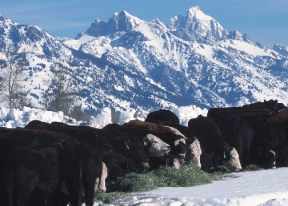
Figure 9.2 illustrates lambs consuming hay from a feeder.
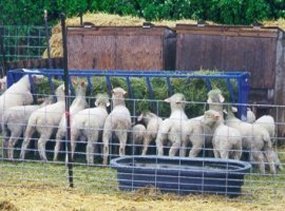
Hay is a primary feed in the ration of ruminants and nonruminant herbivores.
For ruminants, hay is a source of structural carbohydrates, nonstructural
carbohydrates, protein, vitamins, and minerals. Processed legume hay may
also be included in the rations of poultry and swine. Table 9.1 describes
the average nutritional value of one legume and one grass hay. All values
are on a dry-matter basis.
Storage forms of hay include loose, baled, cubed, pelleted, and chopped.
Figure 9.3 illustrates large, round bales in the field.
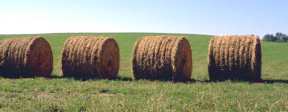
Figure 9.4 illustrates small, rectangular bales in the field.

Feeding forms of hay include long and processed hay. On a nutrient basis,
the cost of the nutrients in the preserved forages is greater than compared
to if the forage was consumed fresh; preserved forages require harvesting
equipment and storage facilities.
As with other forages, there is a compromise between yield and nutritional
value of the forage. Ideally, hay is harvested to optimize the yield and
nutritional value of the forage. In addition, hay should be managed to
provide for subsequent forage production. Nutritional value of hay varies
extensively. The primary factors influencing the nutritional value are
the forage species, maturity at harvest, and efficiency of harvesting,
curing, packing, storing, and feeding. The most important of the factors
is the efficiency of curing, specifically curing time and weather. To
minimize losses as a result of excessive curing times, cure during periods
of high temperature and low moisture. Also consider the use of mechanical
conditioning, chemical conditioning, and/or preserving agents to reduce
losses associated with the curing period.
The primary forages used for hay production include legumes, grasses,
and forage grains. Selection of forage species is influenced by growing
conditions and animal requirements.
The initial step in hay production is harvesting or cutting the forage.
Figure 9.5 illustrates a swather harvesting grass forage for hay.
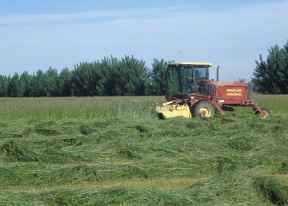
Timing of harvest is critical to maximize yield of digestible nutrients
per unit of land. For alfalfa, the recommended stage of harvest is the
mid to late bud stage. For grasses, the stage of maturity at harvest varies
with species of grass. In general, recommended stage of maturity at harvest
is boot to early head stages. For grass-legume mixtures, harvest during
the ideal maturity for the predominant species. At the time of harvest,
the moisture content for the forages will be approximately 60-75% for
grasses and 70-75% for legumes. Depending on management objectives, forages
may either be harvested in evening or morning hours. To maximize nonstructural
carbohydrate content, cut in the evening hours. To optimize drying time,
cut in the morning hours.
The second step is the forage is cured. Curing is the process in which
harvested forage is dried in the field prior to baling.
Figure 9.6 illustrates alfalfa forage curing in windrows in a field.
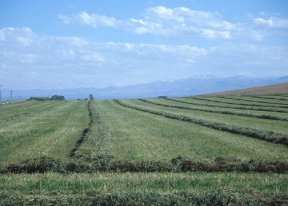
Forages are cured to improve nutritional value of the forage and promote
storage of the feedstuff. Harvested forage may be raked to facilitate
the drying process. In some climates, drying the field is not a practical
option. In these climates, hay is baled, placed into storage and allowed
to dry to minimize nutrient losses associated with curing.
The third step is packaging and storing the forage. Baling is the primary
method to package forage.
Figure 9.7 illustrates a round baler baling in the field.
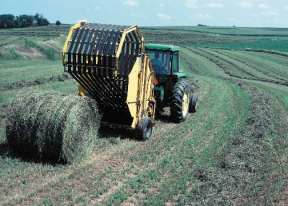
The optimal moisture content at the time of baling is 15-18%. The optimal
moisture content at baling is a compromise between leaf loss in the field
and nutrient loss during storage.
Nutrient losses during cutting, curing, packaging, storing, and feeding
will occur. To maximize digestible nutrient yield per unit of land, it
is necessary to minimize losses associated with hay production. In general,
normal losses range from 20-40%. Under nonoptimal conditions, losses may
exceed 75%.
Initially following harvest, the forage plant will continue to respire.
Until the moisture level of the forage is reduced to 40% or less, plant
enzymes will continue to metabolize nutrients in the forage. The primary
losses associated with respiration include nonstructural carbohydrates
and protein. The extent of losses due to respiration is primarily influenced
by the weather conditions during curing; dry, hot climates minimize losses.
Oxidative losses are also primarily influenced by the weather conditions
during curing. Leaching losses range from 4-15%. Under more adverse conditions,
losses due to leaching may be as high as 40%. The primary nutrients leached
are water soluble proteins, carbohydrates, and vitamins. Again, extent
of losses due to leaching is primarily influenced by the weather during
curing. Sunlight influences the vitamin content of the forage. Sunlight
causes a decrease in vitamin A, an increase in vitamin D, and an increase
in vitamin E.
Hay baled at greater than 20% moisture content is susceptible to heat
damage during storage. The excess moisture promotes the growth of microorganisms.
As the microorganisms grow, they generate heat. The heat will decrease
the nutritional value of the forage via the Maillard or browning reaction.
If the forage is allowed to reach 160-180 degrees Fahrenheit, spontaneous
combustion may occur. Additional storage losses are primarily a result
of exposure to moisture. To minimize losses, it is recommended to store
hay indoors. In general, dry-matter loss for hay stored indoors is 5-10%.
The extent of nutrient loss for forage stored outdoors is influenced by
the weather conditions and type of hay. The optimal climate conditions
for hay storage are cool and dry. The primary nutrient losses due to weather
during storage are nonstructural carbohydrates. Provided hay is appropriately
cut, cured, packaged, and stored, hay may be stored for years with minimal
losses in nutritional value. Hay is the most effective long-term method
to store forages.
Losses may also be the result of mechanical processes. During cutting
of the forage, incomplete forage recovery in the field contributes to
mechanical losses. In addition, as the forage is cured, packed, stored,
and fed mechanical losses do occur. The primary plant components lost
are the leaves. In legumes, losses range from 3-35% and grasses range
from 2-5%. As the nutritional value of leaves is greater than the stems,
leaf loss has the potential to significantly impact the nutritional value
of the forage. The extent of herbage loss due to mechanical processes
is influenced by the moisture content of the plant material and the equipment.
To minimize losses associated with mechanical processes, manage handling
time, frequency, and equipment.
Forage maturity at harvest has a significant impact on the nutritional
value of the forage. The optimal time to harvest is the time that produces
the maximum yield of digestible nutrients per unit of land. In addition,
it is also important to consider the gastrointestinal tract and the nutrient
requirements of the animals consuming the forage. For ruminants, the increase
in structural carbohydrates associated with maturity of the forage will
lead to a decrease in rate of digestion, passage rate, and forage intake.
The net effect will be a decrease in nutrient intake, potentially limiting
production. In contrast to ruminants, horses are able to increase the
passage rate and partially compensate for the lower quality forages. Thus,
the effect of more mature forages on nutrient intake and production is
less in horses as compared to ruminants.
Advancing maturity of a forage is associated with various changes in the
forage. As a forage matures, forage yield increases, protein and nonstructural
carbohydrate contents decrease, structural carbohydrate content increases,
and digestibilities of nutrients decrease. As described earlier, advancing
maturity is also associated with a decreased ratio of leaves to stems.
The nutrient content (i.e. protein and nonstructural carbohydrate contents)
and the nutrient digestibility of leaves is greater than stems. In addition,
as a forage matures the cellulose and lignin contents in the stems increase
and the nutritional value of the stems decreases.
As described, as a forage matures, there is an inverse relationship between
forage yield and nutritional value of the forage. The relationship is
increasingly significant when you consider buying and selling hay. In
the absence of a system to account for nutritional value of the forage,
the hay grower maximizes profit by maximizing yield and the animal producer
purchases a product with minimal nutritional value. The relative feed
value (RFV) method has been developed to account for the nutritional value
of the hay in the valuation system. The relative feed value is one factor
determining the value of the hay per unit of mass (i.e. ton). RFV does
not account for the protein quantity or quality of the forage. Relative
feed value has no units. The relative feed value may be calculated for
a range of forages. The relative feed value may be used to compare similar
types of forages. To determine RFV, calculate digestible dry matter, abbreviated
DDM, using the following equation: % DDM = (88.9 - (% ADF x 0.779)). Next,
calculate the dry matter intake, abbreviated DMI, using the following
equation: % DMI = (120 / % NDF). Then, calculate the RFV using the following
equation: RFV = (% DDM x % DMI) / 1.29. Table 7-17 on page 140 of the
text describes the relative feeding value of various forages.
The following discussion is a brief discussion on the assessment of nutritional
value. As assessment of nutritional value was discussed in Module III,
the discussion will focus on points specific to the evaluation of hay.
As with other feedstuffs, the assessment of the nutritional value of the
forage will provide an estimate versus a precise value. Evaluation of
the nutritional value of a forage uses objective and subjective methods.
In general, forages are bought and sold based on analytical methods. In
the U.S., the National Forage Testing Association administers a voluntary
lab certification program in an effort to standardize the testing of forages.
The initial analysis of the nutritional value of hay is a sensory analysis;
primarily visual. The relative number of buds, blossoms, and seed heads
provide an indication of maturity. The relative amounts of leaves to stems
and the size of the stems provide indications of nutritional value. In
addition, the color is analyzed; the ideal hay is bright in color and
contains no dark forage. Bleached or dark forages indicate issues with
curing and/or storing. High quality forages have minimal amounts of foreign
materials such as weeds and soil. Olfactory analysis is also important.
Forage with an unfavorable odor may have a reduced nutritional value,
reduced palatability, and, in extreme cases, may be toxic to the animals.
As with other feedstuffs, the initial step in an accurate laboratory analysis
is to collect a representative sample of the feedstuff. Recommendations
on collecting a representative sample will vary by feedstuff. For hay,
it is recommended to submit a sample representative of the lot. A lot
of hay is defined as hay from the same cutting, similar field, same stage
of maturity, and same species and variety. To sample the hay, use a core
sampling tube or probe and collect 20 random samples per lot of hay.
Figure 9.8 illustrates use of a probe to collect hay samples.
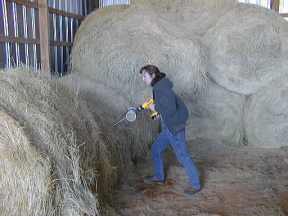
The samples should be stored and shipped in airtight containers.
In the laboratory, the hay will be analyzed via proximate analysis and
detergent fiber system. For details on the procedures, refer to Module
III. A minimum dry-matter content for hay is 85%. The crude protein content
is positively correlated with the quality of the hay. Crude protein is
one factor often used to value hay. Excess ash indicates the presence
of soil contamination. Neutral detergent fiber and acid detergent fiber
provide an estimate of the fiber content. NDF and ADF are used to value
hay. Energy value of hay may be expressed as TDN and/or NFC. Near infrared
analysis is a relatively new method used to value forages. NIR is a quick,
inexpensive, computerized method to determine the nutritional value of
forages. NIR determines the major chemical components of feeds. To perform
a NIR analysis, the sample is ground and dried. Then, the sample is placed
in a spectrophotometer and exposed to NIR light. The radiation is reflected
by the sample, converted to electrical energy, measured, and the measurement
is transferred to a computer. The computer compares the value to a wet-chemistry
derived database of a similar feed sample to determine the nutrient composition
of the forage. The NIR analysis is only as accurate as the database allows;
the feedstuff being sampled should be accurately represented by a feedstuff
in the database.
Previous Page | Right click this page to print.